MARTIAL ART of LOM
HWARANG DO AND KOREAN BUSHIDO
MARTIAL ART of LOM
HWARANG DO AND KOREAN BUSHIDO

LOM is a hwarangdo (the hwa pronounced as “f”) science fiction novel -- that is to say a Korean bushido/martial arts novel whose dystopic storyline also runs on robotics, road wars, low riding, street gangsterism, a future American apartheid and Toltec parallel universes thrown into the mix.

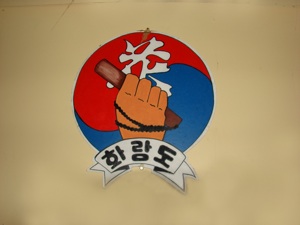
Master Instructor Jesse Lechuga consulted the author on the scenes depicting hand to hand combat and on the esoteric aspects of the martial arts in LOM, particularly in the development and use of chi, the essential energy that permeates the universe and that manifests in living things as a biomagnetic or bioelectric energy.

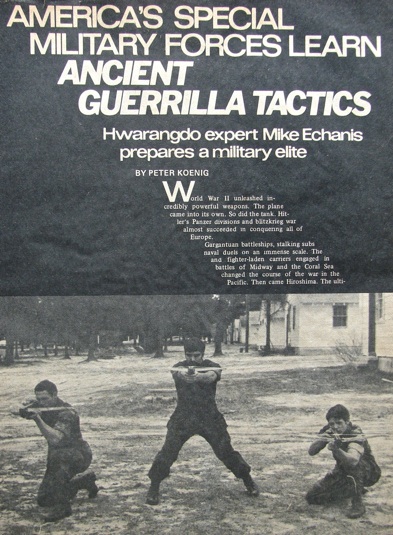
Photograph of Master Instructor Jesse Lechuga by Bob Donnely
The true warrior way of the East cannot be understood without understanding chi. (The author
believes that the ancient warrior way of Cemanahuac--the One World now called North and
Central America--also practiced a form of chi cultivation but that is another discussion.)
Chi (or ki in the Korean) is not typically understood or cultivated per se in Western combative sports.
In fact it’s very existence is questioned in certain quarters of the scientific world and by professional
skeptics. Yet the cultivation and mastery of ki is a fundament of Eastern martial arts and traditional
healing--and in fact has been incorporated by certain elite military units in the U.S. Armed Forces.
Black Belt Magazine January 1977
Article by By Peter Koenig
As for the reference to Korean bushido -
Bushido is generally understood to refer to the warrior way of the Japanese samurai and not generally associated with Korea or Korean martial arts. Yet Korea and Japan actually are actually more akin than commonly understood. There is a history of enmity even war and invasion but there also has been a rich history of an interchange of commerce and culture between these two ancient nations.
The new Supreme Grandmaster of Hwarangdo, Taejoon Lee, refers to Hwarangdo as Korean bushido. As he explains in his book, Hwa Rang Do: Defend, Take Down, Submit, Hwarangdo was not just a martial art in Korean history and culture. Hwarangdo was a martial culture within Korean society that can be likened to Japanese bushido because like the samurai of bushido the Hwarang perfected their martial arts, practiced physical disciplines, followed Buddhist-based spiritual teachings and a strict moral code of conduct. And they valued honor and minimalist aestheticism above material possession, ostentation and luxury.
Samurai and bushido are often likened to European knights and their code of chivalry. And so,
the Hwarang of Korea were a knighthood. Hwarangdo is Korean bushido. (Similarly and known even less were the knighthood and sacred warrior ways of Cemanahuac or Pre-European America, a subject that is a central element in LOM and a topic for another discussion.)
Modern Hwarangdo was introduced by the Lee brothers, Jo Sang and Jo Bang, to America in the 1980s
but it was Dr. Jo Bang Lee who actually established Hwarangdo as a martial arts institution in the
United State as he had done in Korea.
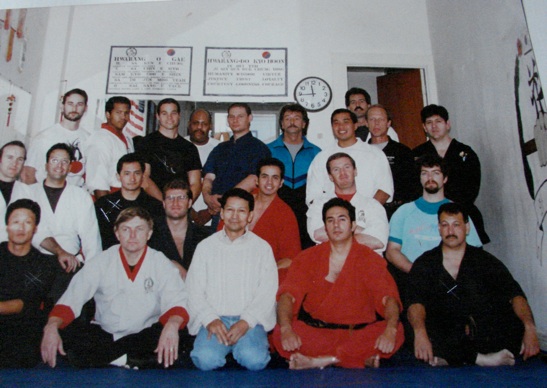
Hwarang group picture including Master Instructor Jess Lechuga bottom row at right, senior Master Instructor Vicente Montegro at center, the first American Hwarang Do Black Belt under Grandmaster Jo Sang Lee. Next to him is Bob Dugan, the first American Hwarang Do Black Belt under Supreme Grand Master Jo Bang Lee. Also, Gil Kim at left, first row, the first American Hwarang Do Master Instructor. Two of Master Instructor Lechuga’s Black Belt students, Bob Donnely and Joe Nepomuseno, second row, third from the left.
As a young man, Jesse Lechuga had the distinct honor of having been personally selected
by Supreme Grand Master Jo Bang Lee to take the Hwarang Do Black Belt test on May 1, 1984.
Master Instructor Lechuga also received the honor of Supreme Grand Master personally assisting him with the setting up of his first dojang in the San Fernando Valley.
Master Instructor Lechuga has provided training to the LAPD ‘s South Bureau CRASH Unit. Former three time Pro welterweight kickboxing champion Ric “the Mongoose” O’kane acknowledges Jesse Lechuga as one of his training mentors. Lance “Mount” Whitaker is another professional fighter who acknowledges Instructor Lechuga as a training mentor.

Master Instructor Jesse Lechuga with students in the first San Fernando Dojang.
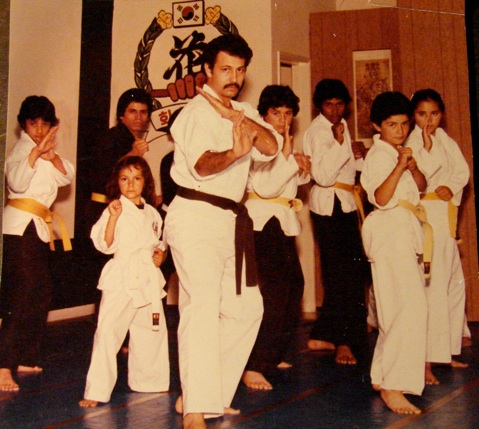
Master Instructor Jesse Lechuga with students in the first San Fernando Dojang. The author’s daughter, Felicia Xilonen is the White Belt at
Instructor Lechuga’s right.
The author expresses his eternal gratitude to Dr. Jo Bang Lee and Senior Master Instructor Jose Montenegro for the honor they bestowed on our family name when they took the author’s brother, Jesse Lechuga into the World Hwarang Do Assoociation. The author salutes the new Supreme Grandmaster of the World Hwa Rang Do Association, Taejoon Lee for assuming the formidable responsibility of continuing in his father’s footsteps and taking the art and institution to new levels into the twenty-first century.
Master Instructor Jesse Lechuga’s Hwarang flag

(Atl-Tlachinolli, Nahuatl symbol of sacred warfare; link for image source)
Master Instructor Jesse Lechuga continues to teach martial arts in the City of San Fernando. He teaches in a private dojang and outdoors at historic Brand/Mission Park.
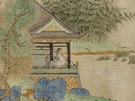
The Elegant Night from Music of China (compilation album) - The Metropolitan Museum of Art